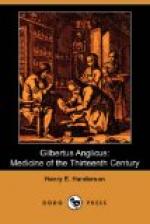In fracture of the ribs (flexura costi) Gilbert recommends a somewhat novel plan for the replacement of the displaced bone. Having put the patient in a bath, the physician rubs his hands well with honey, turpentine, pitch or bird-lime (visco), applies his sticky palms over the displaced ribs, and gradually raises them to their normal position. He also says (f. 183a), the application of a dry cup (cuffa vero cum igne?) over the displaced rib is a convenient method for raising it into position.
Of fractures of the forearm Gilbert simply says that they are to be recognized by the touch and a comparison of the injured with the sound arm. They should be diligently fomented, extension made if necessary, and then treated like other fractures.
Dislocation of the atlo-axoid articulation (os juguli) he tells us threatens speedy death. The mouth of the patient is to be kept open by a wooden gag, a bandage passed beneath the jaw and held by the physician, who places his feet upon the shoulders of the patient and pressing down upon them while he elevates the head by the bandage, endeavors to restore the displaced bone to its normal position. Inunctions of various mollitives are then useful.
Dislocations of the lower jaw are recognized by the failure of the teeth to fit their fellows of the upper jaw, and by the detection of the condyles of the jaw beneath the ears. The bone is to be grasped by the rami and dragged down until the teeth resume and retain their natural position, and the jaw is then to be kept in place by a suitable bandage.
In dislocation of the humerus the patient is to be bound in the supine position, a wedge-shaped stone wrapped with yarn placed in the axilla, and the surgeon, pressing against the padded stone with his foot and raising the humerus with his hands, reduces the head of the bone to its natural position. If this method fails, a long crutch-like stick is prepared to receive at one end the axillary pad, the patient is placed standing upon a box or bench, the pad and crutch adjusted in the axilla, and while the surgeon stands ready to guide the dislocated bone to its place, his assistants remove the bench, leaving the patient




